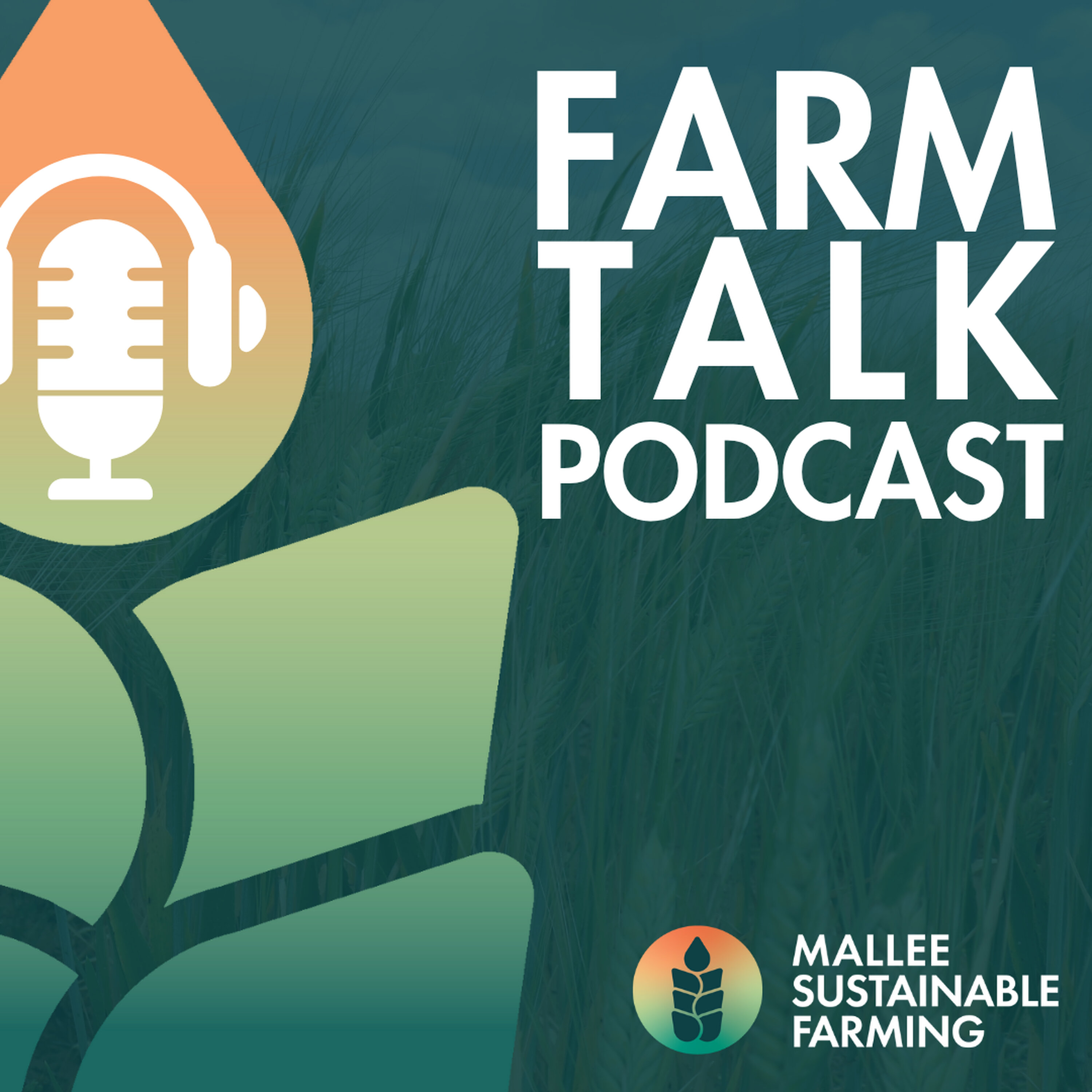
Riverine Plains
'Farmers inspiring farmers'
On the Riverine Plains podcast we cover the topics relevant to Australian farmers - and particularly those on the Riverine Plains.
You can check out more of our project at riverineplains.org.au
Riverine Plains
Crop protection: Talking CROWN ROT with Dr Steve Simpfendorfer
Dr. Stephen Simpfendorfer joins Senior Project Manager, Kate Coffey, to unravel the complexities of Fusarium Crown Rot in wheat production. Crown Rot has the potential to cost farmers, with losses that could mount up to $23.4 million, and the culprit is lurking in a staggering 75% of tested paddocks.
We navigate through the maze of contributing factors, from the shift in farming practices to the nuances of soil health and crop rotation history. With Dr. Simpfendorfer's insights, we grasp the full picture of how wet seasons, larger stubble volumes, and subsurface soil acidity can amplify the disease, threatening our cereal crops right at the critical grain fill stage.
Together with Dr. Simpfendorfer and with the support of GRDC, we are aiming to equip farmers and agronomists with the tools to be proactive and overcome the crown rot challenge.
Predicta B DNA soil testing undertaken by Riverine Plains Farming System Group has shown that farmers in our region could lose 23.4 million in wheat production this year due to the stubble-borne disease, fusarium crown rot. My name is Kate Coffey and our team at Riverine Plains are partnering with GRDC and New South Wales DPI to improve farmers and agronomists understanding of the extent and impact of this disease. In the project we'll also test and promote management options to reduce yield loss to cereals. Today I'm going to have a chat with senior plant pathologist Dr Stephen Simphendorfer from New South Wales DPI at Tamworth. How are you today, stephen? Yeah, good thanks, kate. Why do you think? We found medium to high levels in 75% of the wheat paddocks that we tested this year.
Speaker 2:I think the easy answer to that is probably that you've started looking. So you're in quite an uh, interesting area down there in the Riverine Plains. That's sort of you know on that, on that edge of you know, starting to look for it. So you know, as I said there before we're chatting, like the easiest way to not have a problem is don't look for it. But I think it's just start to look.
Speaker 2:But there's a number of underlying factors. So certainly rotational history is a big part of it. So the more cereals you've got in rotation, we know that Fusarium crown rot is a stubble borne pathogen on our all our cereal crops, winter cereal crops and also on grass weeds. And I think, just as you see, whatever happens, you know you get practice changes within farming systems. Pathogens adapt. You know some changes may benefit some and disadvantage others. But just with your region you're in which you know fortunately you've reduced the amount of stubble burning over time so you're returning more stubble and getting all those benefits for moisture storage and things. You tend to just bring things along with it and in this situation the one that loves the cereal stubble is Fusarium crown rot. So there'll be a tight link to rotation but also, I guess the thing when you have issues like Fusarium crown rot pop up it's usually a run of sequences of seasons can really play into it as well, and I think that's what's happening, not just, you know, in riverine plains, your area, but also more widely with the run of good seasons.
Speaker 2:So, you know, 2020, 2021, 22 really quite wet and we know that, in terms of inoculum for fusarium crown rot, it's a function of percentage of plants that get infected and you actually need moisture to get plants infected in the first place by fusarium. So we've had seasons that have favoured that. But it's also a function of the amount of stubble produced, the amount of, you know, cereal residue left in paddocks and with those good seasons we've had big yields and big inputs of stubble back into the system, which has then got the crown rot fungus in it. You've got bigger inoculum loads. So we just haven't seen that expression. So you're getting infection, big inputs of inoculum, but we're not seeing that stress during grain fill and getting those whiteheads which gives us the big yield loss until last year, and that's why people are starting to see it. So, yeah, there's just a run of situations. I think is why we're there and, yeah, certainly riverine plains is not unique, but it's great that we're increasing awareness through this project and your efforts.
Speaker 1:Thanks, Stephen. And do you think the fact that we've got a lot of subsurface acidity would impact the amount of fusarium that we're seeing in the tests?
Speaker 2:Yeah, and I guess this is the thing whenever I talk Fusarium, I'm really thinking about in distinct phases. So, in terms of the acidity doesn't impact on the infection or the ability of plants to get infected. Yeah, that's not related to pH or acidity or other things. What that soil acidity is more about the expression, the potential for yield loss in plants that are infected with crown rot, because there's a really tight link to the amount of stress during grain fill and how much that infection from crown rot in the base of plants clogs up the xylem, the water flow tissue, and really restricts your ability to fill heads and, obviously, anything that restricts root growth. So, whether it be acidity for you guys, or whether you've got root lesion, nematodes or compaction or other things, anything that stops the wheat plant from accessing water easily and makes it harder for it to do it, that's where you'll get that stronger interaction with crown rotting, those infected plants, and you'll get more expression, more yield loss. So, yeah, certainly there's a huge interaction.
Speaker 2:I guess the one too, when you're first trying to commit to growers and they've got a problem is often around tree lines, is the canary in the coal mine to look at, because you've got the root systems for the trees competing for water, and what you'll see in really droughted years it knocks the crop growth where the roots are extracting water out of the crop. But in those better years, eden just that extra competition for water from the tree roots. That's where you'll see your whiteheads from crown rot express first, and a real indication then to go. Well, let's look through the rest of the paddock for the amount of basal browning, which is an indication of the amount of crown rot infection. The whiteheads are only an indication of expression within plants that aren't affected. So it's it's. It's not the easiest disease for, for growers and advisors get their head around, but it's really not that complicated. I've made a career out of it, so it can't be that hard.
Speaker 2:So yeah but it's just a few little tips like that to convince growers Like convincing them in the first place is often the hardest thing, particularly when in your, so your environment, you're in you. Up where I'm in Tamworth, northern New South Wales and particularly northwest New South Wales, crown rots have the biggest problem and we've been dealing with it for decades. But why we see it so often is we more reliably get expression. We feel under hotter grain field temperatures compared to where you are, and what you tend to be in is this cycle where you know they get a tough finish, get a hot finish. They see whiteheads and crown rot. Crown rot's the biggest thing since sliced bread. Then you go back into a season with softer grain field conditions and they don't see the expression but the infection's still there. So they're in this aware, unaware, unaware, aware cycle. So it's really just trying to convince people to look at the base of browning as that infection indication. And yeah, the whiteheads are purely expression in a tough finish.
Speaker 1:So even-. Headlight a bit later, indication and yeah, the whiteheads are purely expression in a tough finish. Yeah, so when they've got that, um, that brown in the bottom, in the base of the, the wheat in the stem there, um can they be getting yield loss even though you're not seeing the whitehead?
Speaker 2:Yeah, this is the thing that's, and I guess we've had something like a seed treatment which is delayed I won't mention its name because they can't get it yet but where we're seeing that, we're actually being able to pull that apart and show you know, at subclinical levels, where you're not seeing whiteheads, you are still getting year loss. It's reducing biomass early in crops which, if you've got it across your whole paddock, you don't visually see, and it knocks around the tillering as well so yeah, there is a you know there's that five, potentially ten percent without the expression of whiteheads, that it's actually doing for it.
Speaker 2:I think that's going to be. I think, as we look more, it's probably there, you know, low levels and not, you know, not getting the big hot finishes and getting those whiteheads, but it's costing us more than we think. Uh, really interesting too. We've had a phd student who's just finished who looked at also nitrogen interaction and showing that crown rot infection, even in fairly well watered situations, is actually knocking our nitrogen use efficiency as well. Now, in his data from a controlled environment study, you had a 14% reduction in nitrogen use efficiency. So we don't really feed that into our impacts of crown rot now. But nitrogen's a big input cost for growers and you've got this infection, the base of restricting the plant's ability to, you know, to move that nitrogen around the plant and and convert that into to you know, yield and protein and therefore you know economics. Then, yeah, it's costing more than we think.
Speaker 1:And Stephen, given that farmers are now in the next week, are starting to sow canola and then they'll move on to wheat, is it too late now for them to test for this fusarium crown lot, if they're concerned?
Speaker 2:I don't think it's ever too late. I guess the issue is whether they can, what they can practically do with that information. So it's probably getting late to actually be able to say, well, I'm gonna change what I'm doing. But a lot of rotations are locked in by herbicide usage, as you'd know anyway, so that can restrict what they can probably go to. But I'd still urge them for that awareness to still test, know what you're sitting on. Information is power and, yeah, certainly going forward, knowing what their levels are, they can probably tweak a few things if they get it back in time. So it's usually about a two-week turnaround, whether it's a stubble test or a predictor bee, and you know they might potentially look at well you know, not sowing a more susceptible variety.
Speaker 2:You're probably not a big durum area down where you are anyway, but durum is very susceptible to fusarium crown rot. So if you had a medium to high, you just wouldn't go near that. And yeah, certainly if we come back with some hives you might roll out of the bread wheat and into barley, which tends to mature earlier and just escape the moisture stress, you know, and there's inter-row sowing options and other things. But, yeah, probably more. It's an awareness.
Speaker 2:And I guess the other thing I'll just babble on now about is we know that the fusarium headlights, the white grains and pink grains we had in 2022 when we had a really wet grain field conditions, we know that that was actually caused by the same pathogen that causes fusarium crown rot.
Speaker 2:It just caused a different disease called fusarium head blight, which infects through the anthers, the flowers, but it's the same pathogen doing it.
Speaker 2:And what we know is from all the testing is our levels of head blight in 2022 were linked to the amount of crown rot in the basal plant. So knowing what your crown rot levels are in paddocks could be really useful if we end up in the wet of spring, as to. Then you know, triage paddocks as to which ones are more likely to have a headlight problem and I might, you know, be able to do something during that flowering period in terms of fungicide usage to restrict my headlight so I don't get those white, pink rain issues again. So it's certainly pink, green issues again. So it's certainly, yeah, useful for that side of things as well. And the thing I'm obviously a massive advocate of testing, I think it reveals a lot, and it's that background information of rotation, what they've done with stubble management, other things, I think is really powerful for the growers to get their heads around of what's driving this particular disease in different directions. So, yeah, still a lot of value in testing.
Speaker 1:Thanks, Stephen. So you mentioned like a couple of management strategies that farmers can do. I think you said inter-row sowing and swapping barley out for wheat. Yeah, yeah. If they have a high level or they suspect they have a high level, what other options are they that they can do to reduce that risk of loss?
Speaker 2:Yeah, so certainly we know that within wheat varieties in particular, we know they vary in what we call tolerance to crown rot infection. So tolerance is the ability to maintain yield in the presence of disease. So certain varieties just don't lose as much to it. So there's certainly options there. Yeah, I guess, guess the thing and I hope to have suggested it's so interactive with stress during grain fill. So there's a lot of things they can do in terms of trying to manage their stored soil moisture and matching things to the season. So that can be in their nitrogen inputs as well. Like, if you put too much N on up front and burn up your stored moisture, you produce a really big canopy, um, you know, and a big yield potential. But if your spring doesn't hold, that's when your crown rod expression will be worse. So you know, I think there's. You know, when you're in an environment where you can do it, you can be a bit more conservative with your, you know, with your f sewing or or up front in and then look at opportunities. Well, if I'm in a good year, I can uh, top dress and get more in in the system for later, just to not compromise yields. So yeah, there's certainly things for that. Zinc, um is one that's important nutrition wise, but it's really about not being zinc deficient, and zinc deficiency tends to be a problem more on alkaline soils, um, and it's really about just making sure you're not below that, that deficiency level. You can't keep throwing zinc at it and make the problem go away. So, yeah, I think we know too. Certainly you know Fusarium grain infection is not a big issue for any seed retained from 2023. We just weren't wet enough during flowering. But any seed from 2022, just be a bit cautious. We know that we've introduced crown rot into paddocks through infected seed that occurred from Fusarium heplotting in 2022. So if you've got any 2022 seed and you haven't had it tested, I'd just be a bit cautious there and certainly make sure you use a seed treatment so you've got um your vibrance and your evergarden energy at the higher rates of uh registered.
Speaker 2:First suppression of, you know, seed borne infection. They don't protect you from what's you know infect from theble, but they stop that seed transmission and we did some work last year. It's actually quite alarming. You know that. You know the levels of grain infections. So 5% grain infection can still be introduced. Up to 15% crown rot infection into a paddock, into plants. So yeah, that's if you don't use a seed treatment. So you eliminate that with the use of those seed treatments and stephen.
Speaker 1:I heard at a grdc update that there's been some work done on higher seeding rates sort of further in northern new south wales that um had an impact on the crown rot. Did you want to comment on that? Is that something farmers could try?
Speaker 2:yeah, I think, I think. Yeah, anyway, I'm probably a bit out on the period. That was work done with grain and runner alliance, so maury street and ben um there. So you, the thing with that is what we suspect happened was an interaction at those higher seeding rates in that season last year. What it actually did is it brought maturity forward so it used up water early at that higher seeding rate. The higher seeding rates were all targeted as a weed management strategy, trying to increase competition. But, yeah, inadvertently, what happened is it actually brought grain field forward a week or two and reduced that stress interaction. So we think that's how it's happened.
Speaker 2:I think they're going to capture some more information to make sure that's the situation. Just a little nervous, I think you know this is just a function of research. I think we need more seasons and a few more sites to really say you know that's the way to go. Because that interaction in my head could go another way, like if you actually sow a high seeding rate and do alter your maturity and bring it forward, there is a potential you could increase your frost risk too.
Speaker 2:So I'd hate to say let's go all double our seeding rates and then everyone gets frosted and they're going to remember me as the person, so I'd be a little cautious on that. I think we need to need to pull that apart a bit more before we we put that out there. But, yeah, certainly interesting, you know, and certainly interesting and I think that work was brilliant. It really shows how strong that interaction with stress during grain fillies, with crown rot, and that's what I think they did in the studies that manipulated that part of the interaction. That, yeah, whether that's reliable, I think we really need to get a bit more data.
Speaker 1:Thanks, Stephen. And so what would be your take home messages for farmers that are listening now and thinking maybe I should be checking if I've got a crown rot problem?
Speaker 2:Yeah, I think, and you know it's a constant hard slog. I think you know, test, test, test. So just yeah, don't bury your head in the sand. Yes, there's nothing you can do in crop with crown rot. So once you you've sown your crop and things, it's all set what you're going to get. It can, I guess, affect if you know you've got really bad crown rot infection and you know you're in for a tough spring. Now you're not going to lock in forward contracts and that sort of stuff. So it can help with that stuff.
Speaker 2:But I think certainly tests, know what the levels levels uh you've got there and you know then then we can.
Speaker 2:We can have start having discussions around the best way to manage it, but you're really flying blind. So there is rules of thumb. We know that the more cereals that you have in rotation, the more likely that you are to have high crane rot levels. But there's certainly paddocks that have been continuous cereals and don't have a problem because they didn't have the pathogen there in the first place. So it's really without testing. You're really playing a bit of Russian roulette High probability if you've got a heap of cereals you're going to be in that bad level. You can have paddocks that are low and that's what I guess we're trying to get away from is, you know, just these total assumptions? And oh no, that should be fine. And you know we talked there before.
Speaker 2:Like you know, when high levels in your cereal stubble of the crown rot pathogen, often a one-year break crop is not enough. A single canola crop is not enough, because it's not the stubble that's the enemy with crown rot, it's the amount of cereal stubble with the crown rot fungus in it that's the problem. And when that gets really high, it takes longer to bring that down to below damaging levels. And the other thing too is really a break crop is only as effective as the season it's grown in. Really, you know, a break crop's only as effective as the season it's grown in. So if you get a really dry in crop, you're not getting decomposition of the cereal stubble under, say, a canola canopy and you're not breaking down the you know the cereal stubbles. You're not getting rid of the crown or fungus.
Speaker 2:So, yeah, my key messages are certainly yeah, test and and know, know what you got. Yeah, talk to your agronomist and and get involved. Like, yeah, the whole um we talked about that the whole Donald Trump attitude. You know, if you don't want a COVID problem, then simply don't test. I think we've got to move beyond that with Crown Rot as well. Like I think a lot of situations it's really been just denial. It's too hard, we don't want to know about it. We just won't test and we won't know. And you're just going to be in this cycle where you get wh in tough finishes and everyone's upset and yeah, why haven't I got resistant varieties, why haven't I got this?
Speaker 2:And yeah, it's not an easy disease. There's no strong resistance in varieties. It's all partial genes, yeah, and even though we've got a seed treatment, hopefully available in 2025, it's not the silver bullet I like. Yeah, magic bullet, I should have said, but anyway, that's just for some fans out there. Um, but yeah, it's not the sole solution. We still need those integrated management strategies well.
Speaker 1:Thank you very much for your time today, steven um. You are a wealth of information on this topic and we're so privileged to have you here today to to give the farmers in the region a bit of insight into how they can manage this problem, and I'd also like to acknowledge the GRDC who have invested in this project.
Speaker 2:No worries. Thank you for your time.
Podcasts we love
Check out these other fine podcasts recommended by us, not an algorithm.

GRDC Podcast
Grains Research and Development Corporation
Grains Convo
Grower Group Alliance
AgVic Talk
Agriculture Victora
Farms Advice Podcast
Farms Advice
Podcasts – RealAgriculture
RealAgriculture
Soils For Life
Soils For Life
MSF Farm Talk Podcast
Mallee Sustainable Farming
CommBank Agri Podcast
commbankagripodcast
AgriFutures On Air
AgriFutures Australia
Sustainability Further
Banish
Humans of Agriculture
Humans of Agriculture
Farmers Helping Farmers
VicNoTill
